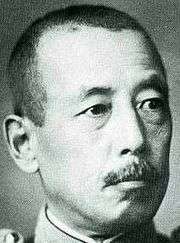Otozō Yamada
| Otozō Yamada | |
|---|---|
|
General Otozō Yamada | |
| Native name | 山田 乙三 |
| Born |
November 6, 1881 Nagano prefecture, Japan |
| Died | July 18, 1965 (aged 83) |
| Allegiance | Empire of Japan |
| Service/branch |
|
| Years of service | 1903 – 1945 |
| Rank | General |
| Commands held | |
| Battles/wars | |
Otozō Yamada (山田 乙三 Yamada Otozō, 6 November 1881 – 18 July 1965) was a general in the Imperial Japanese Army during World War II.
Biography
A native of Nagano Prefecture, Yamada graduated from the 14th class of the Imperial Japanese Army Academy in 1903. He was promoted to lieutenant in February 1905 and taught as an instructor at the academy. He was promoted to captain in September 1912, and graduated from the 24th class of the Army Staff College in November.
A cavalry officer, his rise through the ranks was steady. He was promoted to major in June 1918 and appointed an instructor at the army cavalry school, receiving a promotion to lieutenant-colonel in August 1922. In August 1925, he was promoted to colonel and appointed commander of the IJA 26th Cavalry Regiment. In 1926, he was Chief of Staff of the Chosen Army. He served in the communications section of the 3rd Bureau of the Imperial Japanese Army General Staff from 1927–1930.
Yamada was promoted to major general in August 1930 and appointed Commandant of the Cavalry School. From 1931–1932, he returned to the field as commander of the IJA 4th Cavalry Brigade, before resuming a number of administrative positions (including that of Commandant of the Imperial Japanese Army Academy) to 1937. He was promoted to lieutenant general in August 1934.[1]
With the start of the Second Sino-Japanese War in 1937, Yamada was named commander of the IJA 12th Division, based in Manchukuo. He became commander of the IJA 3rd Army in 1938, and that of the Central China Expeditionary Army from 1938–1939.
Yamada was promoted to full general in August 1940, and was recalled to Japan to assume the post of Inspector-General of Military Training from 1940–1944. He also served as a member of the Supreme War Council during this period.
In July 1944, Yamada returned to Manchukuo as final commander in chief of the Kwangtung Army,[2] but soon advised Imperial General Headquarters that it would be impossible to hold the border with the Soviet Union with the forces allocated. With no aid forthcoming from Japan, Yamada attempted to organize large numbers of poorly trained conscripts and volunteers into eight new infantry divisions and seven new infantry brigades. When the Soviet Army invaded Manchuria on 9 August 1945, Yamada's makeshift forces were shattered within days.[3]
At the surrender of Japan, Yamada was taken as a prisoner of war to Khabarovsk in the Soviet Union, where he was sentenced to 25 years in a Soviet labor camp for war crimes primarily related to the activities of Unit 731.
Yamada was released in 1956 and was repatriated to Japan where he died in 1965.
See also
References
Books
- Frank, Richard B. (2001). Downfall: The End of the Imperial Japanese Empire. Penguin (Non-Classics). ISBN 0-14-100146-1.
- Fuller, Richard (1992). Shokan: Hirohito's Samurai. London: Arms and Armor. ISBN 1-85409-151-4.
- Hayashi, Saburo; Cox, Alvin D (1959). Kogun: The Japanese Army in the Pacific War. Quantico, VA: The Marine Corps Association.
External links
- Ammenthorp, Steen. "Yamada, Otozo". The Generals of World War II.
- Wendel, Marcus. "List of Commanders of the Kwantung Army". Axis History Factbook.
